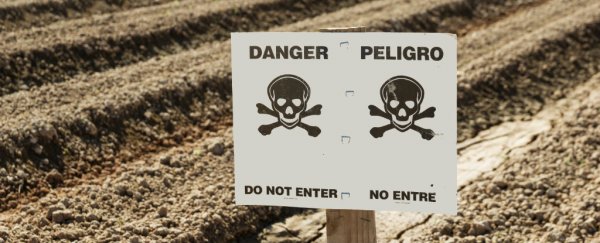
In a secret bunker on the German-Polish border back in 1939, Nazi agents were overseeing the production of a recently discovered chemical called chlorine trifluoride (codenamed Substance N). As far as deadly chemicals go, this one pretty much ran the gamut of things that could kill you - it boiled when it was exposed to air, exploded when it touched water, was lethal when inhaled, and produced the similarly deadly substance, hydrofluoric acid, as it decomposed. The Nazis tested it out in flamethrowers (because of course they did), and found it could burn at temperatures of over 2,400°C.
But in the end, as the SciShow video above explains, Substance N was so dangerous, even the Nazis wanted nothing to do with it.
Yep, they'll blow you into bits as soon as you touch them, and they'll kill you if you so much as breathe in a millionth of a gram of them, and they'll debilitate you with nothing but a really, really terribly foul smell - strap yourself in to learn about five of the most dangerous chemicals known to science.
Fortunately for the future of humankind, the Nazis had planned to make 90 tonnes of Substance N every single month, but only ended up producing 30 tonnes of it in total. It's referred to as the most vigorous fluorinating agent known to science - fluorinating agents rip other molecules apart and replace their hydrogen atoms with fluorine to produce an unquenchable fire.
The result? "It's much more dangerous to handle than even fluorine gas, which, as anyone with a degree in chemistry would tell you, is not a sentence you get to say very often," says Hank in the video above.
Next up, we have the most explosive compound ever produced, the extremely fun to say azidoazide azide. As Hank notes, nitrogen does what it does because it just wants to be left alone. A nitrogen atom will happily bond with another nitrogen atom to create one of the most stable molecules on Earth, thanks to its triple bond.
But what happens when you have 14 nitrogen atoms all stuck together with zero triple bonds, which means every single one of them is dying to escape and form tighter bonds elsewhere? Well, you get azidoazide azide - a substance too sensitive to measure how sensitive it is.
I'll let Hank run you through the remaining three deadliest chemicals in the video above, but let's just say you're going to be meeting the most toxic chemical in the world, the stongest corrosive agent in world, and yep, the world's smelliest chemical.
And if you can't get enough of chemicals that could kill you multiple times over, here's a demonstration of nitrogen triiodide - a chemical so volatile, a mosquito landing on it triggers an explosion:

